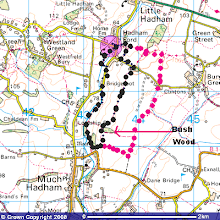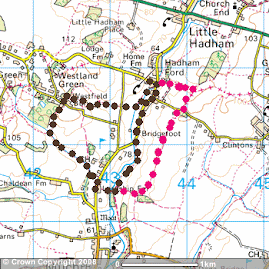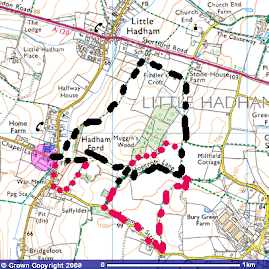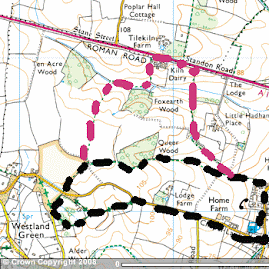
A morning walk in increasingly oppressive temperatures and humidity proved worthwhile as I photographed a green veined white butterfly. This specimen, shown here,  was observed feeding on the nectar from the marjoram that grows wild along the banks of the River Ash south of the Ford. A common and expected butterfly, but good to record with the camera. Also, photographs of common darters in flight Again, a first for the year. One especially pleasing capture being of a pair ovipositing (egg laying) in the River Ash towards Lordship Farm. Note the red male holding the female as she dips her tail into the water, laying one egg at a time. This procedure can carry on for 3 - 6 minutes and the eggs normally hatch within 2 weeks, unless laid after September in which case they remain dormant (diapause) and hatch the following spring. The larvae take just one year to develop before emerging in the morning in late June and begin their adult life. Also pleasing was to capture the male in flight, shown here.
was observed feeding on the nectar from the marjoram that grows wild along the banks of the River Ash south of the Ford. A common and expected butterfly, but good to record with the camera. Also, photographs of common darters in flight Again, a first for the year. One especially pleasing capture being of a pair ovipositing (egg laying) in the River Ash towards Lordship Farm. Note the red male holding the female as she dips her tail into the water, laying one egg at a time. This procedure can carry on for 3 - 6 minutes and the eggs normally hatch within 2 weeks, unless laid after September in which case they remain dormant (diapause) and hatch the following spring. The larvae take just one year to develop before emerging in the morning in late June and begin their adult life. Also pleasing was to capture the male in flight, shown here.
 was observed feeding on the nectar from the marjoram that grows wild along the banks of the River Ash south of the Ford. A common and expected butterfly, but good to record with the camera. Also, photographs of common darters in flight Again, a first for the year. One especially pleasing capture being of a pair ovipositing (egg laying) in the River Ash towards Lordship Farm. Note the red male holding the female as she dips her tail into the water, laying one egg at a time. This procedure can carry on for 3 - 6 minutes and the eggs normally hatch within 2 weeks, unless laid after September in which case they remain dormant (diapause) and hatch the following spring. The larvae take just one year to develop before emerging in the morning in late June and begin their adult life. Also pleasing was to capture the male in flight, shown here.
was observed feeding on the nectar from the marjoram that grows wild along the banks of the River Ash south of the Ford. A common and expected butterfly, but good to record with the camera. Also, photographs of common darters in flight Again, a first for the year. One especially pleasing capture being of a pair ovipositing (egg laying) in the River Ash towards Lordship Farm. Note the red male holding the female as she dips her tail into the water, laying one egg at a time. This procedure can carry on for 3 - 6 minutes and the eggs normally hatch within 2 weeks, unless laid after September in which case they remain dormant (diapause) and hatch the following spring. The larvae take just one year to develop before emerging in the morning in late June and begin their adult life. Also pleasing was to capture the male in flight, shown here.
In all, 8 butterfly species were recorded, with a newly emerged, brilliantly marked peacock and a very worn and old small tortoiseshell also depicted.



A pied wagtail (juvenile) was photographed on the short course at Ash Valley G.C., where swallows fed over the 18th fairway and jays squawked from the nearby oaks. Fledgling kestrels were heard in several trees, with at least 4 examples of early, if not maiden, flights being observed. These were recognisable by their clumsy landing technique, i.e. flying into a tree and crashing into the leaves with wings open. No understanding of air brakes as yet!
was photographed on the short course at Ash Valley G.C., where swallows fed over the 18th fairway and jays squawked from the nearby oaks. Fledgling kestrels were heard in several trees, with at least 4 examples of early, if not maiden, flights being observed. These were recognisable by their clumsy landing technique, i.e. flying into a tree and crashing into the leaves with wings open. No understanding of air brakes as yet!
 was photographed on the short course at Ash Valley G.C., where swallows fed over the 18th fairway and jays squawked from the nearby oaks. Fledgling kestrels were heard in several trees, with at least 4 examples of early, if not maiden, flights being observed. These were recognisable by their clumsy landing technique, i.e. flying into a tree and crashing into the leaves with wings open. No understanding of air brakes as yet!
was photographed on the short course at Ash Valley G.C., where swallows fed over the 18th fairway and jays squawked from the nearby oaks. Fledgling kestrels were heard in several trees, with at least 4 examples of early, if not maiden, flights being observed. These were recognisable by their clumsy landing technique, i.e. flying into a tree and crashing into the leaves with wings open. No understanding of air brakes as yet!


















































